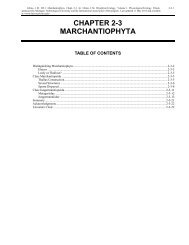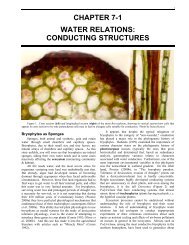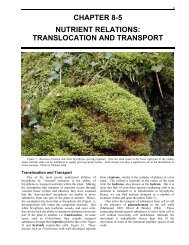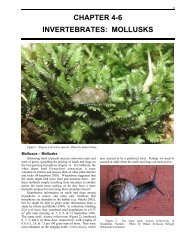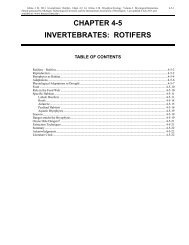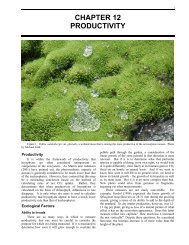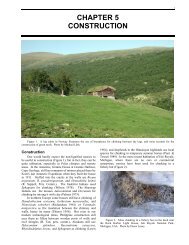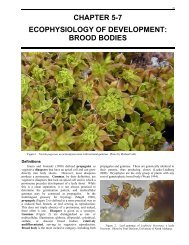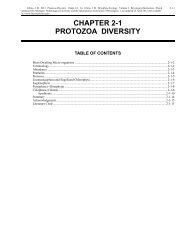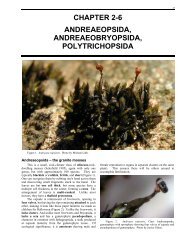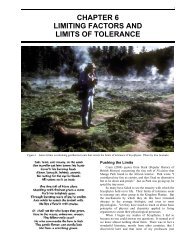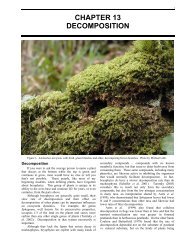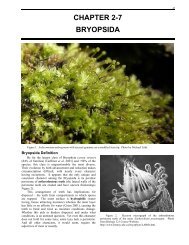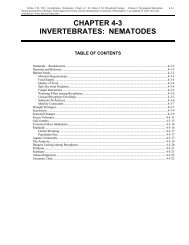chapter 8-3 nutrient relations: nitrogen - Bryophyte Ecology ...
chapter 8-3 nutrient relations: nitrogen - Bryophyte Ecology ...
chapter 8-3 nutrient relations: nitrogen - Bryophyte Ecology ...
You also want an ePaper? Increase the reach of your titles
YUMPU automatically turns print PDFs into web optimized ePapers that Google loves.
16 Chapter 8-3: Nutrient Relations: Nitrogen<br />
other bryophytes seem unable to survive. Could this in<br />
some way relate to the higher annual temperatures of its<br />
tropical habitat?<br />
Assuming that bryophytes operate as do tracheophytes,<br />
NO3 - , once in the plant, is converted to NH4 + . In leaves,<br />
the intermediate product, NO2 - , is reduced by nitrite<br />
reductase (an enzyme that facilitates the addition of<br />
hydrogen and loss of oxygen from NO2 - during the<br />
photosynthetic electron transport process). No intermediate<br />
product is released and the final product is NH4 + . Since<br />
photosynthesis provides the NADH (nicotinamide adenine<br />
dinucleotide, the active coenzyme form of vitamin B3) and<br />
ferredoxin needed for conversion of <strong>nitrogen</strong> oxides to<br />
NH4 + , the conversion process is enhanced by the same<br />
things that enhance photosynthesis – high light and warm<br />
temperatures (Salisbury & Ross 1978). Thus, more<br />
ammonium is produced.<br />
nitrite reductase<br />
NO3 - → NO2 - → NH4 +<br />
nitrate nitrite ammonium<br />
Brown (1982) suggested that the pH or alkalinity<br />
affects availability of N for plants, with NO3 - being more<br />
available in neutral or alkaline soils and NH4 + in acidic<br />
soils and water. But NH4 + is usually toxic to plants in any<br />
appreciable quantity. Sironval (1947) found that NH4 + ions<br />
caused degeneration of the caulonema of Funaria<br />
hygrometrica and Southorn (1977) found they caused<br />
morphological abnormalities in the same species. Killian<br />
(1923) likewise found morphological abnormalities in the<br />
leafy liverwort Scapania. On the other hand, Burkholder<br />
(1959) found that cultured bryophytes did equally well on<br />
both NO3 - and NH4 + salts. An interesting consequence of<br />
pH differences was suggested by Machlis (1962). In<br />
Sphaerocarpos texanus, male plants are smaller than<br />
females in the field. Machlis attributed this to the ability of<br />
male plants to absorb NH4 + ions more readily than females,<br />
causing them to have a lower pH, which could suppress<br />
growth. He supported this suggestion by growing the<br />
plants on potassium, which caused no pH change, and<br />
likewise no reduction in the size of male plants.<br />
In a study designed to determine the effects of various<br />
forms of N on bryophyte function, Alghamdi (2003)<br />
studied the popular, fast-growing aquarium moss<br />
Taxiphyllum barbieri (Java moss). He found that the<br />
benefit to the moss depends on what parameter you<br />
measure (Figure 2). For example, dry biomass increase<br />
was greatest in high NO3 - concentrations (30 mg/L N),<br />
whereas the greatest increase in length occurred in high<br />
NH4 + concentrations (30 mg/L N). This difference resulted<br />
in the least biomass increase per stem length in high NH4 +<br />
concentrations, despite the relatively high increase in<br />
length in that treatment. The overall appearance of the<br />
mosses in high NH4 + , then, was to appear long and thin<br />
compared to those in other treatments, but not dissimilar to<br />
the plants in the control (standard <strong>nutrient</strong> solution but with<br />
no N source). Based on the lower growth in the NH4NO3<br />
media, Alghamdi reasoned that in the presence of NH4 + , the<br />
NO3 - became unusable because of the inhibition of nitrate<br />
reductase by NH4 + . At the same time, the lower<br />
concentration of NH4 + (15 mg/L N) in combination<br />
compared to NH4 + alone (30 mg/L N) reduced the growth.<br />
This <strong>relations</strong>hip was consistent with much greater growth<br />
at 30 mg/L N than at 10 mg/L N as NH4 + (Figure 2).<br />
Figure 2. Effects of various forms of inorganic N (control =<br />
no N, NO2 - = nitrite, NO3 - = nitrate, NH4 + = ammonium) on<br />
growth in length and biomass of Taxiphyllum barbieri. Box mean<br />
(dot) and median (horizontal line); bottom of box is first quartile<br />
and top is third quartile. Whiskers represent lowest and highest<br />
observations still inside region defined by lower limit Q1 - 1.5<br />
(Q3 - Q1) and upper limit Q3 + 1.5 (Q3 - Q1); * represents<br />
outliers that extend beyond the whiskers; n = 15 sets of 3 stems.<br />
Means with same letters are not significantly different from each<br />
other (DNMRT, α = 0.05). Based on Alghamdi (2003).<br />
NO2 - caused only modest improvements in biomass<br />
and length over the N-free controls (Figure 2), but caused<br />
considerable increase in chlorophyll a (Alghamdi 2003;<br />
Figure 3). The chlorophyll a:b ratio was highest in the high<br />
NO3 - treatment, due to mosses in that treatment having the<br />
least chlorophyll b per biomass of moss, a concentration<br />
even lower than that of the controls (Figure 3). In fact, the<br />
effects of inorganic N form on chlorophyll b resulted in<br />
either no improvement over N-free controls, or depressed<br />
levels of chlorophyll b. Chlorophyll a, on the other hand,<br />
was higher in nearly all the <strong>nitrogen</strong> treatments than in the<br />
controls. Baxter et al. (1992) found a similar but slight<br />
decrease in total chlorophyll concentration in Sphagnum<br />
cuspidatum, typically a submersed species, with increasing<br />
levels of NH4 + , but in Alghamdi's experiments,



